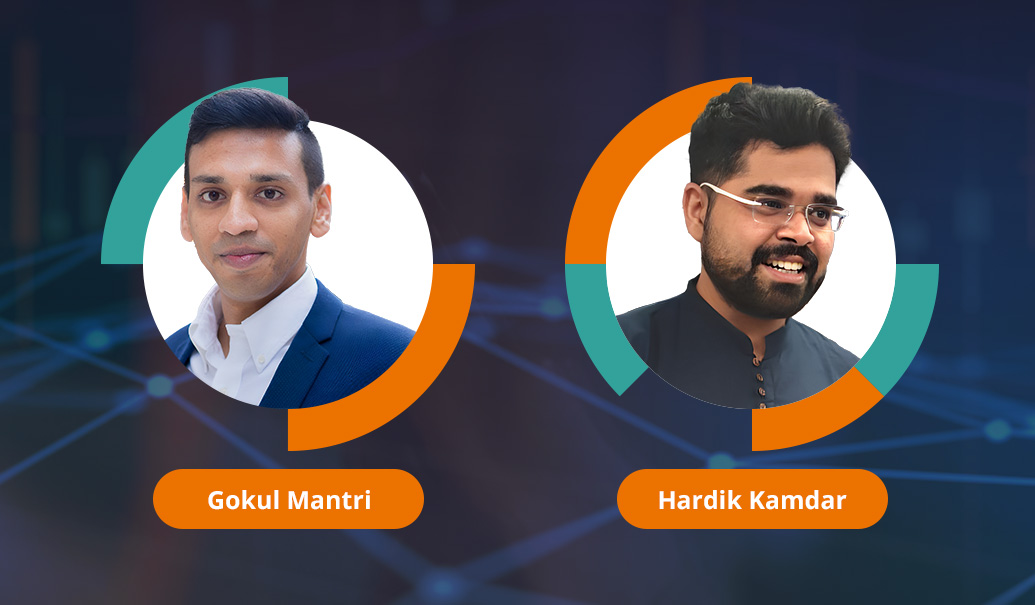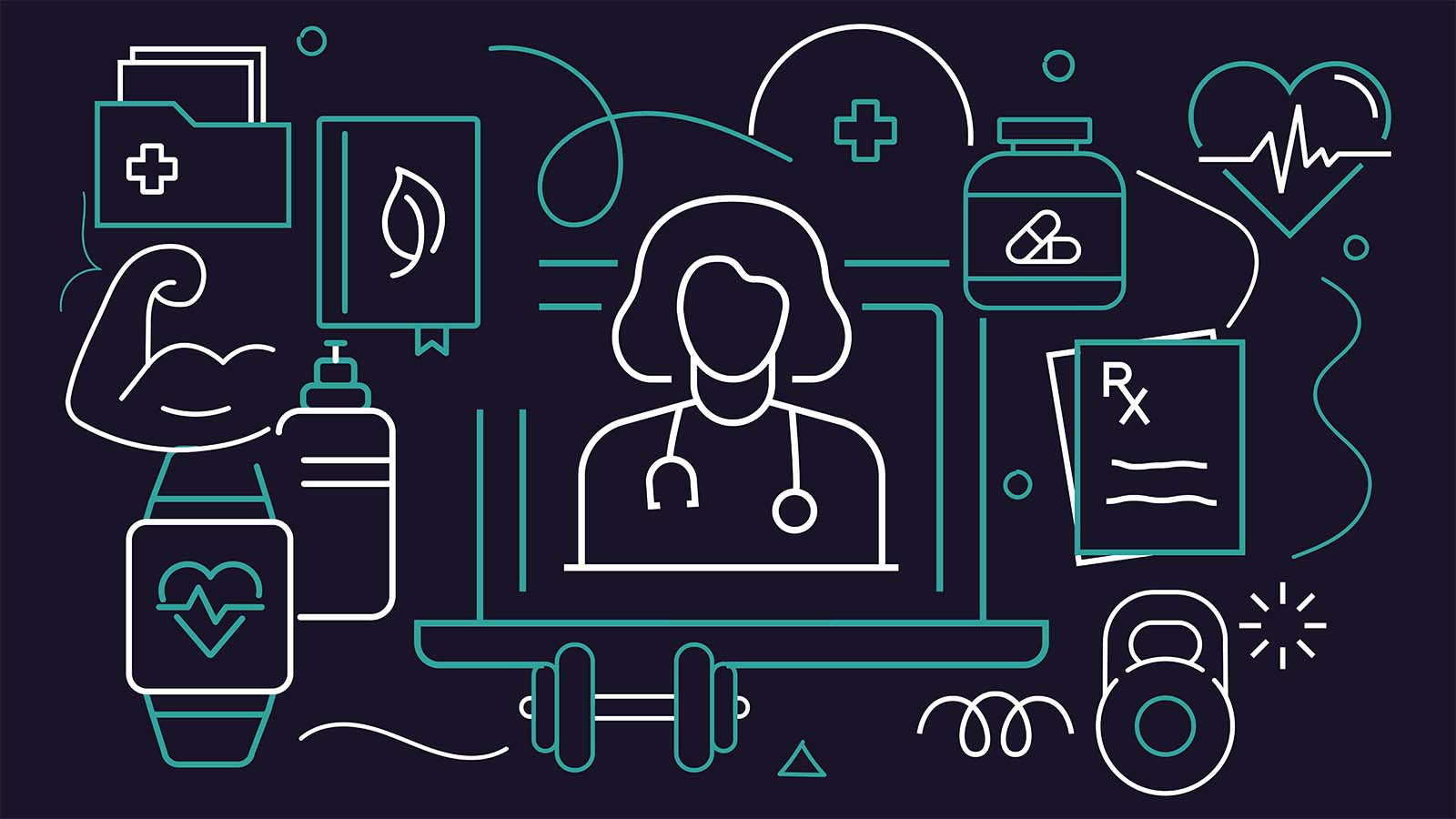The question for life sciences organizations isn’t whether to adopt AI in their processes—it’s when and how quickly. But in the age of peak AI hype, it’s hard to know where to start. We spoke with two ZS experts who work every day with clients from large and midsize global pharma companies to emerging biopharma and biotech businesses to help them bring the benefits of AI-driven insights and efficiencies to their commercial teams.
Hardik Kamdar, senior director, and Gokul Mantri, director are both product managers for ZAIDYN®, our future-ready AI-powered life sciences platform. In their daily conversations with clients, they see what leaders at life sciences companies experience as they evaluate which products best fit their needs, as well as whether to build or buy AI-powered technology. They recommend that life sciences tech buyers guide their purchasing decisions using four factors:
- Enterprise impact: How will the AI product drive revenue growth, improve performance and support business expansion?
- Effectiveness: Does the AI product surface real-time predictions, next best actions and decision support?
- Efficiency: How well does the AI product automate manual work and shorten the time to insight?
- Experience: Does the AI product feature a seamless, intuitive design that empowers headquarter and field teams to execute confidently
Hardik and Gokul shared with us some of the key things that life sciences companies should be thinking about before and during their purchasing journey—especially when looking for technology that’s built specifically to support the needs unique to the life sciences industry.
ZS: Why is it so important for life sciences organizations to have vertical software that’s tailored to their industry?
Hardik Kamdar: Life sciences and pharma organizations operate with complexities and nuances that are unique to their industry, starting with the data itself. For example, how data is acquired, profiled and ultimately used downstream is very different from other industries. Today, pharma companies are looking to leverage technology and AI more deeply, which is why software with domain knowledge built in becomes critical.
Life sciences organizations must have a vertical SaaS platform that is purpose-built for their industry. Such platforms embed deep domain expertise directly into their design, bringing AI models trained specifically on life sciences data and offering out-of-the-box workflows that mirror the industry’s unique ways of working. This alignment makes a tangible difference across the organization by simplifying configuration for administrators, streamlining operations for teams and delivering more relevant insights to end users. A purpose-built solution not only reduces this complexity but also accelerates time to value and drives better outcomes, setting life sciences organizations up for long-term success.
Gokul Mantri: The work at life sciences organizations involves uniquely complex, regulated and data-intensive processes that generic tools can’t adequately support. From clinical trials to drug development and regulatory submissions, tailored software allows for compliance with standards protecting sensitive patient, research and employee data. It should also integrate with specialized life sciences systems. By streamlining workflows and adapting to evolving needs, industry-tailored vertical SaaS software solutions empower life sciences teams to operate more efficiently so they can focus on advancing innovation, improving patient outcomes and bringing therapies to market faster.
“In life sciences, commercial decisions have direct impact on patient outcomes and regulatory obligations. A true vertical platform should deliver trustworthy, defensible insights.”
Hardik Kamdar, Senior Director, ZAIDYN
ZS: What factors come into play when selecting an AI-driven platform, in particular, that’s fit for life sciences?
HK: A true vertical AI platform should be purpose-built to address the unique challenges of life sciences organizations. Several key factors come into play when evaluating a life sciences platform.
First, the platform must have deep domain expertise embedded into its design. Life sciences processes such as incentive compensation, territory alignment, call planning and next best action optimization are highly specialized and require systems that understand their complexity. A platform should also prioritize data integrity, ensure outputs are explainable and auditable, and meet strict compliance standards.
Second, the AI capabilities must be tailored to the industry’s real-world needs. In life sciences, commercial decisions have direct impact on patient outcomes and regulatory obligations. A true vertical platform should deliver trustworthy, defensible insights.
At ZS, we understand these needs deeply. For more than 40 years, we’ve been a trusted partner to the life sciences industry, solving complex commercial challenges and investing intentionally in building technology that integrates the most advanced AI and generative AI capabilities. Our differentiated ZAIDYN strategy combining verticalized software, embedded intelligence, modular extensibility and a strong partnership ecosystem is designed to help life sciences companies drive operational excellence, scale intelligently and lead with agility in a rapidly evolving environment.
GM: Adding to what Hardik said, the life sciences industry has its own specific vocabulary—for example product detailing, call planning and next best action. This vocabulary has specific nuances that wouldn’t be reflected in a standard LLM. The industry also has its own unique processes, especially its indirect commercial model. Sales are based on the relationship between the pharma rep and the doctor who prescribes a therapy to a patient. Commercial ops activities aren’t straightforward like they are in other industries with direct sales.
“To meet rising expectations, life sciences companies must leverage AI to deliver tailored, meaningful engagement at scale. ZAIDYN has helped hundreds of organizations achieve this.”
Gokul Mantri, Director, ZAIDYN
ZS: Why is AI becoming indispensable for commercial teams in life sciences? What is it allowing them to achieve that wouldn’t have been possible before?
HK: AI is becoming indispensable because our clients’ expectations to outperform keep rising. As expectations rise, we need to help teams accomplish more within the same time constraints. AI enables this by streamlining workflows and automating manual, time-consuming tasks, delivering a seamless and efficient experience. For example, instead of a sales rep trying to manually review 500 customers based on sales data, AI analyzes the information up front and narrows it down to the top 10 customers to focus on, while providing guidance on which customers to prioritize first.
GM: The life sciences industry is more competitive than ever. AI has become essential for maximizing impact, delivering stronger outcomes with fewer resources and greater efficiency. But success isn’t about using just any AI model; it requires solutions designed specifically for the unique needs of this industry. Only with the right, industry-specific AI can organizations truly optimize their operations, accelerate decision-making and maintain a competitive edge as the industry continues to change daily. Physicians’ expectations have evolved: They now look for messaging that’s personalized and relevant to their specific context. To meet rising expectations, life sciences companies must leverage AI to deliver tailored, meaningful engagement at scale. ZAIDYN has helped hundreds of organizations achieve this.
ZS: What should life sciences companies be looking for in a platform that will complement and empower their commercial teams, rather than making their jobs more complex?
HK: It’s easier said than done, but the best application of AI is when you don’t even realize that it’s there. It’s about removing steps, making the user’s life easier. For commercial teams to adopt new tools successfully, the technology must streamline their work, not add extra steps.
GM: A philosophy we follow when building our products is to treat them more like they’re an assistant—not something that takes all the action but provides intelligent suggestions and recommendations. It’s more of a companion or a guide, rather than a tool that acts on behalf of the user. The goal is to help people make the right decisions, not to make the decisions for them. The contextual nature of AI allows us to create a seamless user experience, where a user can simply ask a question and get an answer. Adoption becomes much easier when a tool is user-centric and tailored to the user’s specific needs.
ZS: That aligns with making AI feel like a trusted partner as opposed to technology that creates friction. How does ZAIDYN differ from other AI-driven platforms in its collaborative, human-centric approach?
HK: One of our biggest key differentiators is our domain intelligence. Because we know this life sciences terrain so very well, our AI application is far richer than others. Our other differentiator is the user experience and context we’ve built around AI. We have tried to keep it very simple and intuitive so it’s easier for people to adopt. Our secret sauce is our ability to provide extensibility through our platform. This really allows clients to bring their own intelligence into the platform that works in tandem with the models we have created.
ZS: When we say extensibility, what do we mean?
HK: Integrations with new data sources or with processes that are very custom for a given client might not be applicable for all clients. Integration with the client’s own data models and making sure the platform can adapt to a client’s specific needs, not just offering a one-size-fits all solution.
In the life sciences industry, most companies have built their own AI governance councils and are heavily investing to maintain their competitive edge. Our approach allows clients to bring their proprietary intelligence into the platform, whether that’s via custom workflows, specialized datasets or their own AI models. By designing our models to work alongside theirs, we help elevate the overall intelligence of their ecosystem, rather than forcing them to choose between our solutions and the innovations they’ve already built.
ZAIDYN also enables clients to create nuanced, UI-based workflows that are not part of the product. This level of extensibility elevates the overall experience for the users who don’t have to hop around in multiple tools. Instead, they get the intelligence they need delivered right within the context of their immediate work.
ZS: How is AI changing engagements with healthcare professionals (HCPs) and patients?
HK: This is something that is very close to my heart, as it’s what I am working on currently. Let’s talk about how pharma teams engaged with HCPs in the past. About four times a year, life sciences companies generated a long list of HCPs with any known addresses. Then they’d share this list with the reps to go meet with them. Sometimes the HCP might have offices in three different ZIP codes, aligning to three territories. So multiple reps would go meet them in multiple places. Some HCPs would be affiliated with a healthcare organization that has a very specific philosophy about lines of therapy or treatments. None of those nuances were captured anywhere.
With time, we’ve collected so much data to generate insights that make life easier for pharma reps and their organizations. They can easily identify the customers with the highest potential and then design their engagements. For example, if I am a rep meeting Dr. Patel, what should I talk with them about? Does Dr. Patel believe in the therapies I’m sharing? What do the numbers say about what Dr. Patel prescribes? Would Dr. Patel bring more physicians onboard to my therapy because of their impact and influence? In the past, those details were missing.
Now, ZAIDYN captures the data surrounding these interactions related to customer engagement, whether it’s with HCPs or patients. It can also help patients who are going through a life-threatening condition understand what the right treatment path is for them. AI can be your partner along the way, helping patients stick to the treatment plan or identify what indications might work and share these with their doctors who are guiding them through their care. All of these capabilities elevate what engagement looks like for both HCPs and patients.
ZS: What should life sciences organizations be implementing within their technology now to capture that kind of insightful information and put it into action?
HK: The answer depends on what type of product the pharma organization is creating and what makes sense for promoting that product. Does the organization need to prioritize a broader level of patient awareness, or does it need to prioritize reaching key opinion leaders. Sometimes it’s both, but what should come first in the sequence of events? When you can answer nuances like that, AI applications become far more effective.
ZS: How can life sciences organizations mitigate some of the risks of using AI in their technology, especially when handling sensitive healthcare information?
HK: It’s important to handle data properly to avoid regulatory risk. At the same time, it’s important to be sure that your tech provider is protecting your data across clients—that the data isn’t exchanged or shared through the systems or AI models. This kind of data protection is what we build into our core architecture of ZAIDYN. In our products, we mitigate risk at the source, using data that’s compliant and accessible. You should be sure that the right governance is in place in the systems you use. Risks also must be addressed at the source of the data, making sure that sensitive data is not making it into your systems in the first place. Some of our data pipeline masks the data to protect it, so you can’t trace where it’s coming from—not to an individual or back to any private information.
ZS: What are the advantages of buying a life sciences tech platform versus building it?
HK: By buying a platform versus building one, life sciences organizations have the benefit of all the required data starting from a place where it’s centralized and consolidated, which your AI functionalities and AI models need to work effectively.
Clients who buy a platform don’t have to reinvent something that already comes with the product. Let’s say you’re trying to create a portal, and you need to invest in an authentication and authorization module. That’s a very basic example, but you don’t get those things for free when you try to build systems from scratch. And even if you end up investing in those horizontal components, then you need dedicated resources to keep those components up to date with all the necessary security upgrades. When a client subscribes to a product like ZAIDYN, there’s a dedicated team to maintain the platform or its applications.
GM: If a life sciences company builds their own solution, they’ll never benefit from having the latest, greatest technology in the industry. Instead, they’ll be stuck with this internal investment and will incur technical debt.
ZS: What needs to be in place before commercial teams in life sciences can effectively leverage AI-driven platforms?
GM: The team needs a clear sense of what their end state should look like. What do they really want to achieve? What’s the outcome they’re looking for? The next most important thing is having their data in one place in a nice, clean form. AI inherently needs a very data-rich ecosystem to function and provide insights. Centralizing data is one of the most foundational steps for any AI capability to work.
HK: Most of the time, our clients are dealing with multiple vendors. Let’s put on the hat of the IT person who’s working for an organization that has multiple roles to support and different business units across different countries. And there are certain things that the client has strategically decided to keep within their ecosystem, as well as what data and information the organization has decided can flow outside of it.
For our clients, it’s critical to understand those decisions, the “why” behind them and how they will work. You need to go through an organized planning exercise where you identify who’s responsible for what, with a zoomed-out look at how everything will flow together. For example, life sciences organizations typically work with one vendor to manage their HR data, another vendor to do incentive compensation processing and have an in-house solution for their MBO approach to performance. So, how would you work on AI use cases for this scenario? You need to establish who will produce data, who will consume the data, what the AI system should refer to as the source of truth in case of conflicts and what is the right mechanism to deliver intelligence out of this integrated system that is truly actionable.
GM: Governance is essential. Organizations must determine the data that should be accessible and that should remain restricted—and that begins with effective data tagging. Given the sensitivity of certain datasets, it’s crucial to have a clear understanding of what qualifies as sensitive. The right technology platforms, especially those tailored to specific domains, come with built-in governance capabilities. A purpose-built platform offers the benefit of industry-standard controls and preconfigured safeguards designed for specific use cases in life sciences.
ZS: That’s another good reason to buy a tech platform and not try and build it yourself, right? What specific elements should organizations look for in a platform to get the value they’re looking for?
HK: In my experience, organizations should start with functional and nonfunctional requirement lists. Nonfunctional items are things like security, integration and compliance with all the local laws where the company operates. Is the platform GDPR compliant if I do business in Europe? On the functional side, you’ll consider factors like, do you have enough workflows in place for someone to be able to complete their tasks? Or, I want to be able to trace back what goes into the calculation of a given metric. Will the platform be able to sustain the number of users who will need to log into it at once? These are just a few examples.
ZS: What should a life sciences organization be thinking about when it comes to selecting an AI platform that complements their internal resources?
HK: Clients need to identify what they can and cannot do with the people they have. For example, let’s take two types of clients: One that has invested heavily in acquiring data-science-based talent, and the other one that is operating without this type of talent in-house. The first client with the data scientists would need more control and more access to MLOps platforms. Whereas the other client would likely be more interested in the outcomes—understanding how the AI models work and their parameters. Depending on which type of client you are, your functional and nonfunctional requirement lists will evolve. When evaluating an AI platform, they’ll need to ask the right questions to make sure the tech provider is able to support their needs.
ZS: Considering the speed at which AI is expanding its capabilities, how do life sciences organizations find solutions that can adapt and scale as these capabilities expand?
GM: The answer lies in continuous experimentation. AI is evolving at a remarkable pace. Just a year ago, generative AI was the focus, and now we’re seeing the rise of agentic AI. Before that, it was traditional AI and machine learning. This pace of change will only continue. To keep up, organizations must be agile and equipped to address a variety of use cases. That starts with clearly defining your goals, then constantly testing and iterating. That’s why it’s important to have a platform that allows you to continue to experiment and figure out what works best for your business. You need nimbleness baked into your operating model and into your choices of tech to keep up with this accelerating pace.
HK: For a life sciences organization, the underlying core processes—the backbone of what they want to accomplish—will remain more or less the same. But they can now evolve these processes over time as they digitize, integrate, automate and now delegate. All of this depends on what type of data is available and the comfort level of what the organization wants to take on. But if you have a basic understanding of life sciences processes and workflows, adopting AI advances will become much easier. You can test the power of autonomous decision-making at points to see if it works, then slowly but surely expand it to more places in your processes.
ZS: If you don’t understand the process, you can’t understand how to continuously improve it by plugging in AI into the points that are too slow or tedious. Last question for you: What does technology-enabled commercial success look like for pharma organizations in a post-AI world?
HK: Our goal is to improve the overall experience for all users of our life sciences platform, ZAIDYN. This means making our users more efficient so that we reduce the time that each task takes. We want to help them make better decisions faster, leading to better business outcomes. And we want to bring impact to their organizations, whether it’s to help them improve their margins, increase revenue or drive overall growth—whatever matters most to them.
Get our buyer’s checklist for what to look for in a life sciences platform.
Add insights to your inbox
We’ll send you content you’ll want to read – and put to use.













